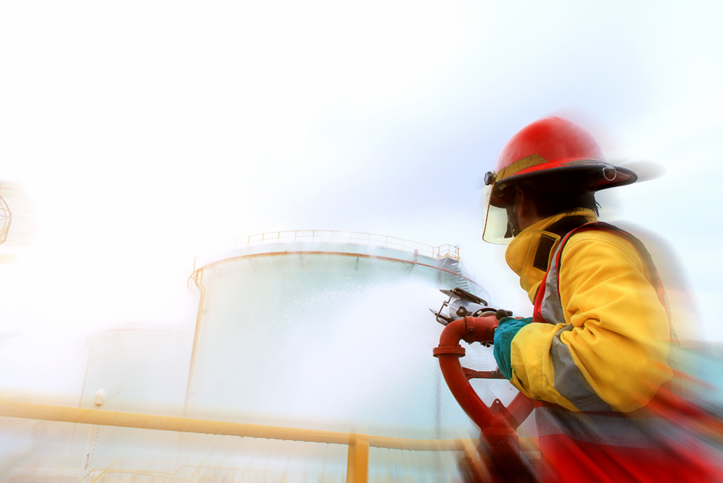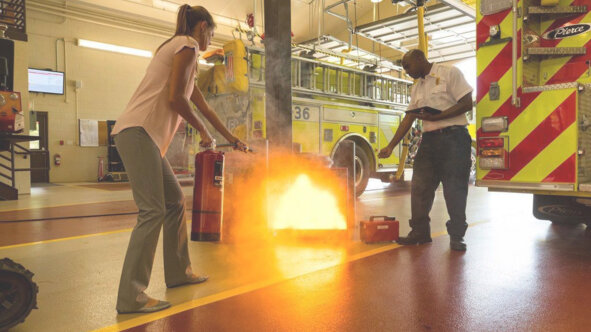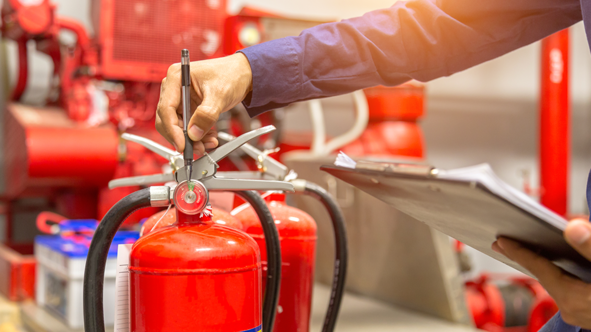Why?
How does a fire extinguisher work? And how to extinguish a starting fire quickly and effectively? You can literally save lives with an efficient and thoughtful evacuation procedure. And with sufficient knowledge of fire prevention and firefighting equipment, you will make a difference in an emergency.
What do you learn?
You will learn everything about fire prevention and firefighting. In addition, you learn how to elaborate an evacuation procedure.
Practical exercises will teach you how to handle fire extinguishing equipment. And you will exchange tips with your colleagues. Finally, you will learn how to apply statutory requirements to the context of your company. This course has a maximum of 12 participants. This leaves plenty of room for interaction and to practice your response in specific situation.
The theory section addresses the following topics:
- How does a fire start?
- What are the causes of fire?
- How do you prevent a fire?
- Various types of fire (fire categories), fire extinguishing equipment, the first intervention team and evacuation procedure and practice.
The practical section teaches you how to use portable fire extinguishing equipment.
The course takes place in a training centre or on the premise of your company. If you opt for the latter, it is important that the parking area of your organisation is large enough for our trucks. Specifically:
- 20 metres long and 4 metres wide at a minimum.
- Clear height of around 6 metres: mind any trees.
- an entrance of 3 metres wide and 4 metres high.
- A sufficiently large turning radius for the tractor and trailer.
This course is part of our Impact-offer

Broaden your view and prepare for a new role. A mix of learning methods helps you acquire in-depth knowledge you can apply immediately. The learning paths are often spread over several days.
Result?
After this course:
- You are aware of the importance of fire prevention in everyday life
- You are able to act quickly and efficiently in the event of a fire.
- You recognise emergency intervention equipment and are able to use it correctly
- You are aware of the dangers associated with fire
- You are able to assess the possibilities for an initial intervention
- You have theoretical knowledge about fire
- You know the different situations that lead to evacuation
- You know the different evacuation techniques and are able to apply them at your company
After the course, you will receive a certificate of participation. As an employer, you can request a qualification test to conclude the course but this is not mandatory.
Compulsory refresher courses
Are you part of the firefighting service? The well-being act requires you to update your training routinely. Our ‘Fire prevention and firefighting refresher’ course' is perfectly suited to that end. You will refresh your knowledge with new techniques.
For whom?
The course is intended for members of the first intervention team, evacuation team and fire prevention service in high-risk companies.
What does the law say?
Each company is legally required to have an in-house firefighting service. It consists of several employees who act efficiently in the event of a fire (hazard). The size of your organisation is irrelevant to this requirement.
A risk analysis determines how many employees the firefighting service must contain. This depends on your company size, type of business operations, and the fire risk.
As an employer, you are legally obligated to provide members of the firefighting service with the necessary training. Raising awareness is important to inform all other employees of fire hazards, what to do in the event of a fire and how to evacuate.
Price
The price depends on how you follow the training.
If your organisation is affiliated with Mensura External Service for Prevention and Protection at Work (ESPPW) and you have prevention units, you can pay with these as long as your balance is sufficient.
Subsidies and financing options
We qualify for all kinds of subsidies and financing options because we are certified by many government agencies and sector funds.
- SME portfolio. Use these certification numbers in your application:
- Members of Mensura External Department for Prevention and Protection: Mensura EDPB - DV.O105072
- non-members: Mensura CONSULT - DV.O101943
- Training cheques - Wallonia
- Sector fund
- Alimento
- Constructiv
Frequently Asked Questions
Is having a firefighting service mandatory?
Yes. Every employer must organise its own firefighting service.
This service consists of several employees who act efficiently in the event of a fire hazard. It is irrelevant how many employees you have. One person in the service must always be present.
A risk analysis determines how many employees the firefighting service must engage. This depends on your company size, type of business operations, and the fire risk.
Who should receive fire training in my organisation?
Every organisation must have several employees that act efficiently in the event of a fire hazard, i.e. the firefighting service. The team members take a specific course that has both theoretical and a practical elements. They learn to participate in a risk analysis, intervene when a fire starts, and carry out an evacuation correctly and quickly.
All other employees must be informed about possible fire risks, the alarm signal, what to do in case of fire, and how to evacuate.






